Kottiyoor
| Kottiyoor കൊട്ടിയൂർ Kottiyur | |
|---|---|
| Village | |
|
The New Narayana Temple, Kottiyoor | |
 Kottiyoor Location in Kannur, Kerala, India | |
| Coordinates: 11°52′35″N 75°51′15″E / 11.87639°N 75.85417°ECoordinates: 11°52′35″N 75°51′15″E / 11.87639°N 75.85417°E | |
| Country |
|
| State | Kerala |
| District | Kannur |
| Languages | |
| • Official | Malayalam, English |
| Time zone | IST (UTC+5:30) |
| PIN | 670651 |
| Telephone code | 0490 |
| Vehicle registration | KL-58 |
| Niyamasabha constituency | Peravoor |
| Climate | Pleasent (Köppen) |
Kottiyoor is a village and the 23rd Wild Life Sanctuary of Kerala, situated in eastern hilly area of Kannur. Kottiyoor is located in the serene hills of Western Ghats. The ancient pilgrimage conducted here yearly, called 'Kottiyoor Vysakha Mahotsavam' attracts thousands of devotees every year. The Vavali river flows through Kottiyoor.[1][2]
Etymology
“Kottiyoor” comes from Koodi(Meeting) and Uuru(Precinct); the name comes from the pilgrimage in the region. The mythology says that this is the place where the holy trinity (Brahma, Vishnu and Shiva), Veerabhadra, Bhadrakali, Shiva Bhutaganas, revered Sages and other holy men came together to complete the Daksha Yaga. It is believed that Sati Devi immolated herself here. The etymology of most of the places on the way to Kottiyoor are also related to the mythology. Sati Devi's voyage to the “Yagashala” can be understood by the names of these area. The place where she desperately felt the need of Shiva and felt sad on his absence is called “Manathana”. The place where Sati Devi cried is now the name of a nearby village called “Kanneer char”. Another village nearby is “Aayothumchal”, this is where Sati felt tired and rested for some time. An ox was provided from a place on the way for the tired Devi to ride, this place is now known as “Kelakam”. There is a place called “Neendunokki” this is the place where Sati peeped at the distant 'Yaga shala' when she heard the noise emanating from there. The place where she had to pay taxation is called - “Chungakunnu”, where she walked slowly became “Mandhemcheri”. The place where she became extremely tired and fell down is “Murchilakadu”. “Mutherikavu” is a temple and the name of a village, it is where the sword which decapitated Daksha, was thrown by Veerabhadra . Stone hearths used for boiling milk came to be known as “Palukachiyamala”.[3]
Geography
Kottiyoor is a hilly village on the eastern side of Kannur district. The terrain is undulating in nature and the extreme eastern side has forests bordering Karnataka state.
Kottiyoor Wild Life Sanctuary
Kottiyoor is declared as a wild life sanctuary by the Government of Kerala.[4] It is the 23rd wild life sanctuary in Kerala. The total area of the zone is 3,037.98 hectares. It is in addition to the Aralam wild life sanctuary in Kannur District.[5] Kottiyoor Wild Life Sanctuary is adjacent to the Bandipur National Park, a tiger reserve park in Karnataka border.[6]
Biodiversity
The place is a part of Northern Western Ghats, (WWF code IM0135), it is classified as a Tropical broad leaf forest. The region is a transition zone between the moist Cullenia-dominated forest in south to drier Dipterocarp forests in north. The region is classified under Critical biodiversity hot spot. The Kottiyoor forest is a part of Nilgiri Biosphere Reserve. Kottiyoor is connected to Wayanad through the Brahmagiri valley which is rich in wild flora and fauna.[7][8][9]
Tourism
Kottiyoor is an exciting tourist spot for biologists, nature sight seers and mountaineering trekkers. Neendunokki, Palukachiyamala, Kelakam are all serene green places suitable for Eco tourism. The forest is serene, a large variety of birds and seasonal butterflies are deen here. Palukachipara's hilltop is a well known location for usual trekkers'.[10]


Pilgrimage-Vysakha Mahotsavam
Kottiyoor Utsavam, the yaga festival in Akkare Kottiyoor Shrine, is conducted yearly for 27 days commemorating the Daksha Yaga. The pilgrimage is on the west bank of Bavali river in a temporary shrine where the Swayambhu linga is present. During the time of pilgrimage the Ikkare Kottiyoor Temple will be closed. Thousands of pilgrims come to this place, the festival is in the rainy season of June–July.[11]
Thruchherumana Temple (Kottiyoor Vadakkeshwaram Temple)
The Thruchherumana Temple or familiarly known as Ikkare Kottiyoor Kshetram is a prominent Shiva Temple, located on the east bank of Vavali river. It special category temple of Malabar Devaswom Board. The temple is mainly famous due to the yearly pilgrimage of Vysakha Mahotsavam in the other shrine on the west bank. The temple is closed during the Vysakha mahotsavam and open during the rest of the year.
Access
The national highway passes through Kannur town. Mangalore and Mumbai can be accessed on the northern side and Cochin and Thiruvananthapuram can be accessed on the southern side. The road to the east of Iritty connects to Mysore and Bangalore. The nearest railway station is Kannur on Mangalore-Palakkad line. There are airports at Mangalore and Calicut. There are road access from Kannur and Thalassery. From Kannur the route is through Chalode, Mattannur and Iritty; from Thalassery the route is through Koothuparamba. Akkare Kottiyoor temple is open during the annual festival for one month whereas the Ikkare Kottiyoor temple is open for 11 months.
- Road-Frequent bus services are available to Kottiyoor from Thalassery and Kannur
Kottiyyor is 125 km from Kozhikode
- Rail-Nearest railway station is Thalassery 60 km
Image gallery
- Festival Time
- Ikkare Kottiyur
 Entry to Akkare
Entry to Akkare Bamboo Flower Maker
Bamboo Flower Maker The Temple Bridge
The Temple Bridge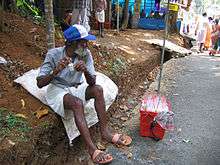 Bubble Maker
Bubble Maker Going to Akkare Kottiyur
Going to Akkare Kottiyur festival view
festival view- Bringing Tender Coconuts
 The Bunyan Tree
The Bunyan Tree
See also
| Wikimedia Commons has media related to Kottiyoor. |
- Kottiyoor Temple
- Kottiyoor Vysakha Mahotsavam
- Thalassery
- Mattannur
- Ambayathode
- Chungakkunnu
- kandapunam
- Erattathodu
Bio-Diversity at Kottiyoor
- Cultural depictions and Biodiversity of Kottiyoor
 Neendunokki town
Neendunokki town- Thrichherumana Temple
 Paalchuram
Paalchuram
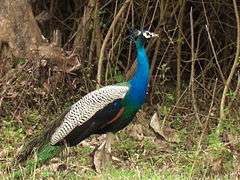 Wild Peacock
Wild Peacock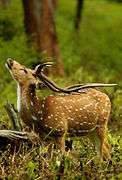 Chital
Chital Indian Baur
Indian Baur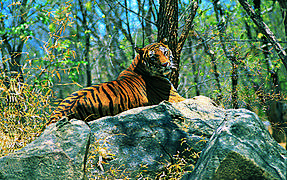 Tiger in Wayanad border
Tiger in Wayanad border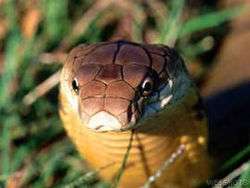 King Cobra
King Cobra.jpg) Bavali bridge to Akkare kottiyoor
Bavali bridge to Akkare kottiyoor
References
- ↑ "Kerala / Kannur News : Huge crowd at Kottiyur temple". Chennai, India: The Hindu. 2006-06-17. Retrieved 2012-05-22.
- ↑ "Huge crowd at Kottiyur temple". The Hindu. Chennai, India. 17 June 2006.
- ↑ "Few Facts about the temple". kottiyoordevaswom Temple Administration. Retrieved 11 August 2013.
- ↑ "Kottiyoor declared wild life sanctuary". Mathrubhumi. Retrieved 11 August 2013.
- ↑ Nazeer, Mohamed (27 April 2011). "Wildlife sanctuary area in Kannur increases". The Hindu. Chennai, India. Retrieved 11 August 2013.
- ↑ "North Western Ghats montane rain forests". Retrieved 13 August 2013.
- ↑ "Southern Asia: Southwestern India". WWF. Retrieved 12 August 2013.
- ↑ "Biological diversity in the Western Ghats and Sri Lanka". Encyclopedia of Earth. Retrieved 12 August 2013.
- ↑ Sudhi, K. S. (June 15, 2013). "Soon, a Kerala Red List of threatened species". The Hindu. Chennai, India. Retrieved 13 August 2013.
- ↑ "Kottiyoor". Mathrubhumi. Retrieved 13 August 2013.
- ↑ "Daksha yaga bhumiyil". Malayala Manorama. Retrieved 10 August 2013.
 |
Kannur | Kannur district | Kodagu district, Karnataka |  |
| Thalassery | |
Kodagu district, Karnataka | ||
| ||||
| | ||||
| Kozhikode | Wayanad | Wayanad |
